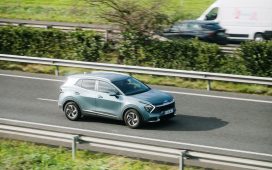
For more than a decade, millions of British motorists have been driving cars with a potentially deadly component right in front of their face. The vehicle makers and the government know about it, but there is little sense of urgency to fix the problem, and a fog of confusion about who should take responsibility.
The issue concerns a part which you would think is there to protect you – the airbag. You might not have heard of Takata, but the company’s faulty safety kit resulted in the biggest recall in the history of the car industry, with around 100 million vehicles affected.
According to data released to Auto Express by the Driver & Vehicle Standards Agency (DVSA), almost 5.3 million of these were in the UK, so there’s a good chance that you’ve been invited to have the potentially deadly components checked or replaced.
And yet, 10 years after the first notices were issued, the official data shows there are still more than 2.2 million cars in the UK alone that have yet to be repaired or checked. There have been excuses from car makers about errors in part orders and shipping delays, while dealers are quoting appointments months in advance.
At the same time, confusion reigns among the car makers, drivers and the DVSA about what’s happening and even what to call the problem in communications with customers. As a result, many drivers don’t realise that taking action could be a lifesaver.
The issue surrounds an explosive cartridge used to rapidly inflate the airbag in an accident. The chemicals inside the Takata components can become unstable, potentially causing the metal housing to rupture when it is triggered in an accident, sending shards of metal into the cabin. At least 27 people have been killed globally – although no one has been hurt in the UK.
Research has shown that the corrosion of the crucial parts is accelerated in hot, humid climates, which means the UK is currently classified as low risk. Drivers in other countries, such as Australia and the US, have been told not to drive some models of car until they are fixed.
But the DVSA has not yet compelled manufacturers to check or replace Takata airbag components and relies on their goodwill to fix the problem. A DVSA spokesperson told us that the “safety recall action regarding the Takata concern has been a precautionary measure and voluntary in nature. However, this remains under constant review.”

They continued: “Manufacturers are taking measures, which include staggering and prioritising safety recalls, as well as monitoring and testing prior to any safety recall launch. Therefore, it is expected that new safety recalls will be launched in the future for this concern.”
This difference between a voluntary ‘service campaign’ and a compulsory recall is crucial. It means the car manufacturers aren’t compelled to comply, may not chase up contact letters, and will experience a huge difference in the response.
Japanese car makers appear the most proactive, generally. At the top of the league of mainstream manufacturers who recalled more than 10,000 cars is Honda, which has reworked 946,700 of the 1,181,654 vehicles affected – a rate of 80.1 per cent.
Need to sell your car?
Find your best offer from over 5,000+ dealers. It’s that easy.
At the other end of the scale, Ford scored a hit rate of just 27.6 per cent on the 270,405 vehicles it needs to rework, according to the DVSA figures.
A Ford spokesperson disputed the numbers: “We are currently at Phase 10 of the recalls with 161,415 of the 219,713 affected vehicles recalled… in line with the agreed phase launching approach. All these customers have been mailed at least once, but the bulk of the owners have been mailed multiple times. The completion rate for the vehicles recalled thus far stands at 42 per cent.”
Audi also argued that the data given to us by the DVSA was inaccurate, and its Takata completion rate for the 4,936 A4 and A6 models affected was much better than the 15.6 per cent quoted.
A spokesperson said: “The data supplied by the DVSA is not for a recall. It is for a ‘service life campaign’. These are issued when the factory requires used parts returned for analysis to assess if a recall needs to be issued. Service campaigns can only be completed if the customer chooses to participate, and because they are voluntary, they have much lower completion rate to recalls.”
Mazda also said this owner apathy is an issue, as is weeding out cars that have been scrapped or exported. A spokesperson said: “When we look at vehicles that are actively being used on the UK roads, there are currently only 6,692 vehicles that need to be updated. That’s two per cent of the 315,343 vehicles affected which are now outstanding.
“These customers are written to and E-mailed on a regular basis, with a follow up call also made. But unfortunately, some customers are not willing to accept that the work needs to be done and avoid booking their car into their dealership at all costs.”
The DVSA guidelines for manufacturers suggest they should “take all reasonable steps to locate and rectify products”, and “are encouraged to be innovative in how they encourage take-up of recall programmes”.

This may persuade – or force – the driver to book their car in for the work, but they may not be able to get it fixed for months. Industry sources told us there simply aren’t the parts available, or the experts needed to fit them. For example, Ford’s spokesperson said: “Our initial ability to action the recall was delayed because more than 50,000 parts sent from China to cover our launch were built incorrectly with the wrong connections. We therefore lost time and had to wait for fresh parts to arrive, which were subsequently caught up in the shipping turmoil caused by the Ever Given ship blocking the Suez Canal in 2021.”
Once the parts are available, it seems there’s a shortage of people to fit them, too. A senior industry figure, who wished to remain anonymous, said: “There is a real lack of technicians in the dealer network, which means workshops are stacked out. The labour rates they can charge back to the manufacturer for a warranty and recall work are about 80-85 per cent of the amount you can charge the public for servicing and repair, and you don’t make the mark-up on the parts either. Dealers will naturally prioritise the better-paid work where they can bill at full whack for everything. It means anyone trying to book in their car to have the airbag checked might have to wait months for an appointment.”
Nissan has found a neat way around this, which also counteracts the ‘apathy’ felt by some owners who simply don’t think the recall is important enough to justify the visit to a dealer – especially on older cars. The company has partnered with the RAC to offer a mobile service, so the work can be completed at home.
This solution is likely to be adopted by more car makers as the pinch on parts and technicians continues. Manufacturers such as Audi are also opting to ‘monitor’ the components to see if any corrosion has occurred and will then replace them at a later date when there is supply available. This may help the car makers, but adds inconvenience for the owner and will naturally result in more cars falling through the net.
As we face warmer and more humid summers, this explosive combination could be a ticking time-bomb, that could lead to a tragedy here in the UK years from now. The Takata airbag scandal might be old news, but it’s not something that should be forgotten or ignored.
Want the latest car news in your inbox? Sign up to the free Auto Express email newsletter…











